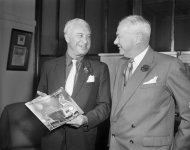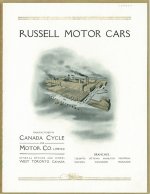The motor industry in Australia was established and developed by a number of firms that often existed for decades. What is important about them is the often distinctive people who worked in them. In the history of Peugeot in Australia certain people and firms stand out. E.W. Brown and the Edwardian motorbikes, A.W.B. Mather and the French Auto Company in the 1920's and postwar the Canada Cycle and Motor Company of Melbourne. This firm was responsible for bringing the 203 to Australia. Companies often disappear with little record but fortunately a company history penned in 1955 survived and was subsequently edited by Thomas Batten.
As the name implies the company dealt in bicycles and was once Canadian owned. A Canada Cycle Company still exists in Canada. The origin of the firm was the bicycle department of the Canadian implement maker Massey Harris. In 1894 Charles Neunhoffer left his post office position and joined as bicycle manager. In 1900 the bicycle division of Massey Harris was sold to Canada Cycle & Motor Co of Toronto. Subsequently the firm was taken over by the Russell Motor Company of Toronto. All the company operations in Australia were closed down except for Brisbane and Melbourne. C.J Neunhoffer was put in charge of the Melbourne branch in rented premises in Elizabeth Street. Bicycle assembly was carried out in their workshop. In 1908 the Melbourne office began the marketing of the Russell motor car. Neunhoffer worked on setting up a state wide sales network. The first examples of the Russell had deficiencies but they later adopted a four cylinder Knight sleeve valve that was well regarded.
In 1913 the Russell Company decided to close the Melbourne operation. Although Neunhoffer was not wealthy he managed to convince the Canadian firm to sell him the business on terms. So from 1914 Canada Cycle and Motor Company was Australian owned.
As the name implies the company dealt in bicycles and was once Canadian owned. A Canada Cycle Company still exists in Canada. The origin of the firm was the bicycle department of the Canadian implement maker Massey Harris. In 1894 Charles Neunhoffer left his post office position and joined as bicycle manager. In 1900 the bicycle division of Massey Harris was sold to Canada Cycle & Motor Co of Toronto. Subsequently the firm was taken over by the Russell Motor Company of Toronto. All the company operations in Australia were closed down except for Brisbane and Melbourne. C.J Neunhoffer was put in charge of the Melbourne branch in rented premises in Elizabeth Street. Bicycle assembly was carried out in their workshop. In 1908 the Melbourne office began the marketing of the Russell motor car. Neunhoffer worked on setting up a state wide sales network. The first examples of the Russell had deficiencies but they later adopted a four cylinder Knight sleeve valve that was well regarded.
In 1913 the Russell Company decided to close the Melbourne operation. Although Neunhoffer was not wealthy he managed to convince the Canadian firm to sell him the business on terms. So from 1914 Canada Cycle and Motor Company was Australian owned.
Last edited:


